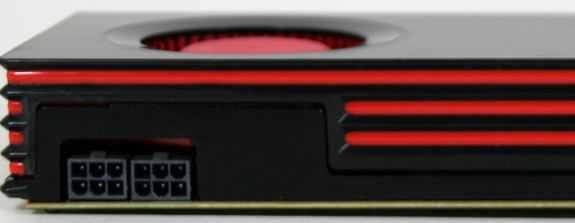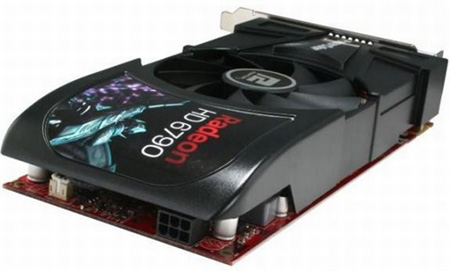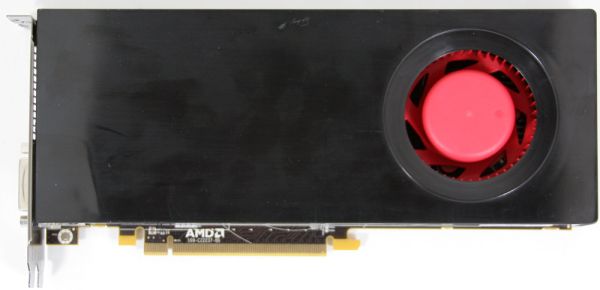AMD's Radeon HD 6790: Coming Up Short At $150
by Ryan Smith on April 5, 2011 12:01 AM ESTThe last couple of weeks after the recent GeForce GTX 550 Ti launch have been more eventful than I had initially been expecting. As you may recall the GTX 550 Ti launched at $150, a price tag too high for its sub-6850 performance. I’m not sure in what order things happened – whether it was a price change or a competitive card that came first – but GTX 550 Ti prices have finally come down for some of the cards. The average price of the cheaper cards is now around $130, a more fitting price given the card’s performance.
The timing for this leads into today’s launch. AMD is launching a new card, the Radeon HD 6790, at that same $150 price point. Based on the same Barts GPU that powers the Radeon HD 6800 series, this is AMD’s customary 3rd tier product that we’ve come to expect after the 4830 and 5830. As we’ll see NVIDIA had good reason to drop the price on the GTX 550 if they didn’t already, but at the same time AMD must still deal with the rest of the competition: NVIDIA’s GTX 460 lineup, and of course AMD itself. So just how well does the 6790 stack up in the crowded $150 price segment? Let’s find out.
| AMD Radeon HD 6870 | AMD Radeon HD 6850 | AMD Radeon HD 5830 | AMD Radeon HD 6790 | AMD Radeon HD 5770 | |
| Stream Processors | 1120 | 960 | 1120 | 800 | 800 |
| Texture Units | 56 | 48 | 56 | 40 | 40 |
| ROPs | 32 | 32 | 16 | 16 | 16 |
| Core Clock | 900MHz | 775MHz | 800MHz | 840MHz | 850MHz |
| Memory Clock | 1.05GHz (4.2GHz data rate) GDDR5 | 1GHz (4GHz data rate) GDDR5 | 1GHz (4GHz data rate) GDDR5 | 1050MHz (4.2GHz data rate) GDDR5 | 1.2GHz (4.8GHz data rate) GDDR5 |
| Memory Bus Width | 256-bit | 256-bit | 256-bit | 256-bit | 128-bit |
| VRAM | 1GB | 1GB | 1GB | 1GB | 1GB |
| FP64 | N/A | N/A | 1/5 | N/A | N/A |
| Transistor Count | 1.7B | 1.7B | 2.15B | 1.7B | 956M |
| Manufacturing Process | TSMC 40nm | TSMC 40nm | TSMC 40nm | TSMC 40nm | TSMC 40nm |
| Price Point | ~$200 | ~$160 | N/A | $149 | ~$110 |
3rd tier products didn’t get a great reputation last year. AMD and NVIDIA both launched such products based on their high-end GPUs – Cypress and GF100 respectively – and the resulting Radeon HD 5830 and GeForce GTX 465 were eventually eclipsed by the GeForce GTX 460 that was cooler, quieter, and better performing at the same if not lower price. The problem with 3rd tier products is that they’re difficult to balance; 1st tier products are fully enabled parts that are the performance kings, and 2nd tier products are the budget minded parts that trade some performance for lower power consumption and all that follows.
While 2nd tier products are largely composed of salvaged GPUs that couldn’t make it as a 1st tier product, the lower power requirements and prices make the resulting video card a solid product. But where do 3rd tier products come from? It’s everything that couldn’t pass muster as a 2nd tier product – more damaged units functional units that won’t operate at lower voltages like a 2nd tier product. The GTX 465 and Radeon HD 5830 embodied this with power consumption of a 1st tier card and the performance of a last generation card, which made them difficult to recommend. This does not mean that a 3rd tier card can’t be good – the Radeon HD 4830 and GTX 260 C216 were fairly well received – but it’s a difficult hurdle to overcome.
Launching today is the Radeon HD 6790, the 3rd tier Barts part and like the rest of the Barts-based lineup, the direct descendent of its 5800 series counterpart, in this case the Radeon HD 5830. As is to be expected, the 6790 is further cut-down from the 6850, losing 2 SIMD units and half of its ROPs; mitigating this some are higher clockspeeds for both the core and the memory. With 800 SPs and 16 ROPs operating at 840MHz, on paper the 6790 looks a lot like a Radeon HD 5770 with a 256bit bus, albeit one that’s clocked slower given the 6790’s 1050MHz (4.2GHz data rate) memory clock.
From the 5830 we learned that losing the ROPs hurts far more than the SPs, and we’re expecting much of the same here; total pixel pushing power is halved, and MSAA performance also takes a dive in this situation. Overall the 6790 has 90% of the shading/texturing, 54% of the ROP capacity, half the L2 cache, and 105% of the memory bandwidth of the 6850. Or to compare it to the 5770, it has 98% of the shading/texturing capacity, 98% of the ROP capacity, and 175% of the memory bandwidth, not accounting for the architectural differences between Barts and Juniper.
Further extending the 5830 comparison, as with the 5830 AMD is leaving the design of the card in the hands of their partners. The card being sampled to the press is based on the 6870’s cooler and PCB, as the 6790’s 150W TDP is almost identical to the 151W TDP of the 6870, however like the 5830 no one will be shipping a card using this design. Instead all of AMD’s partners will be using their own in-house designs, so we’ll be seeing a variety of coolers and PCBs in use. Accordingly while we can still take a look at the performance of the card, our power, temperature, and noise data will not match any retail card – power consumption should be very close however.

At 150W AMD is skirting the requirement for 2 PCIe power sockets. Being based on a 6870 our sample uses 2 sockets and any other design using a 6870 PCB verbatim should be similar, but some cards will ship with only a single socket. This doesn’t impact the power requirements of the card – it’s roughly 150W either way – but it makes the card more compatible with lower-wattage PSUs that only come with 1 PCIe power plug.

As we mentioned previously, AMD is launching the 6790 at $150. With the GTX 550’s price drop its direct competitor is no longer the GTX 550, but rather the closest competitor is now cheap GTX 460 768MB cards, which on average are about the same $150. AMD’s internal competition is the 6850, which averages closer to $160. Technically the Radeon HD 5770 is also competition, but with it going for around $110 after rebate, it’s far more value priced than the 6790 is.
Meanwhile the 6790 name also marks the first time we’ve seen the 6700 series in the retail market. In the OEM market AMD has rebadged the 5700 series as the 6700 series, however that change won’t ever be coming to the retail market, making this the only 6700 series card we’ll see. It’s a bit odd to see one series shared by two GPUs so significantly different, but AMD bases this on the fact that the 5770/6770 and the 6790 are so close in terms of specs; they want to frame the 6790 in terms of the 5770/6770, rather than in terms of the 6800 series. If nothing else it’s a nice correction for the poor naming of the 6800 series; a 6830 would have been the 5830 but slower.
| April 2011 Video Card MSRPs | ||
| NVIDIA | Price | AMD |
| $700 | Radeon HD 6990 | |
| $480 | ||
| $320 | Radeon HD 6970 | |
| $240 | Radeon HD 6950 1GB | |
| $200 | Radeon HD 6870 | |
| $160 | Radeon HD 6850 | |
| $150 | Radeon HD 6790 | |
| $130 | ||
|
|
$110 | Radeon HD 5770 |















69 Comments
View All Comments
SquattingDog - Tuesday, April 5, 2011 - link
"it's LEANING from the past..." should be it's LEARNING from the past. Otherwise a great article, very speedily put out. Looks to be an interesting card, depending on what pricing it is available at here. Of course the 6850/6870 are much better and the 6850 looks to be better bang for buck, but when people cannot squeeze a few extra bucks out of the wallet, it should be pretty reasonable. Especially once the GTX460s are out of circulation, which is bound to happen soon enough.Glad to see more competition and finally some products reaching further down in the retail sector not just OEM from AMD.
ZL1Corvette - Tuesday, April 5, 2011 - link
2nd to last page possible typo:"Last but not least as always is our look at the power consumption, temperatures, and acoustics of the GTX 550 Ti."
Did you mean 6970?
ZL1Corvette - Tuesday, April 5, 2011 - link
See, we all make mistakes. I meant 6790.stm1185 - Tuesday, April 5, 2011 - link
800 Stream Procs, 40 Texture Units, 16 ROPs, 256 bit memory bus. Only the 6970 has a 840mhz clock compared to 750 mhz, and 1050mhz on the memory compared to 900mhz on the 4870.My card has held up well it seems.
james.jwb - Tuesday, April 5, 2011 - link
I have a 4890 with a 2560x1440 screen, and to my surprise, i can play quite a few games at 30fps, and most older ones at 60+fps. Like F1 2010, around 50fps.What a card, eh?
WhatsTheDifference - Tuesday, April 5, 2011 - link
hello. nice card. I play everything at 19x12 with my 4890 (in this case, an msi cyclone soc) with never a problem of any kind. it bloodies the 285's face.kind of a wondrous thing, then, that anandtech.com has banned the 4980 from all benchmarks...ain't it? XD
B3an - Wednesday, April 6, 2011 - link
*rolls eyes* ... They dont have any 2xx series here either. The ATI 4xxx and NV 2xx series do not belong here.If you want to see how your 4890 stacks up simply go the the GPU Bench page to compare.
WhatsTheDifference - Saturday, April 9, 2011 - link
what would you say these are, at least at first sight?NVIDIA GeForce GTX 295
NVIDIA GeForce GTX 285
NVIDIA GeForce GTX 260 Core 216
and
AMD Radeon HD 4870X2
AMD Radeon HD 4870
......?
please make your way to 'index' and 'the test'. or, maybe I'm confusing articles.
now adding the always-juvenile *rolls eyes*
pandemonium - Tuesday, April 5, 2011 - link
Gotta take the bad with that good though.Both the 4870 and 4870x2 run much hotter and take a butt load more power to produce lower framerates. And the 4870 was never a lower tier card by any means. Plus, no DX11 support on the 4870. Not that it's incredibly important, but just another note.
I'd say this is a good example of hardware evolution.
edpierce - Tuesday, April 5, 2011 - link
I disagree. Recent video card innovations have been real unimpressive lately. It really does seem like we are not much further than 3 years ago in terms of visual video card performance. Are we hitting a massive roadblock here?